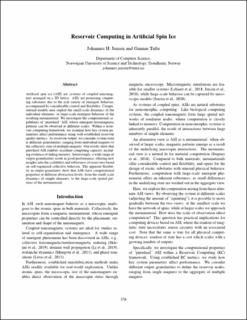| dc.contributor.author | Jensen, Johannes Høydahl | |
| dc.contributor.author | Tufte, Gunnar | |
| dc.date.accessioned | 2021-09-06T10:55:33Z | |
| dc.date.available | 2021-09-06T10:55:33Z | |
| dc.date.created | 2020-12-07T16:01:46Z | |
| dc.date.issued | 2020 | |
| dc.identifier.citation | ALIFE : Proceedings of the Artificial Life Conference. 2020, (32), 376-383. | en_US |
| dc.identifier.issn | 2693-1508 | |
| dc.identifier.uri | https://hdl.handle.net/11250/2773718 | |
| dc.description.abstract | Artificial spin ice (ASI) are systems of coupled nanomagnets arranged on a 2D lattice. ASIs are promising computing substrates due to the rich variety of emergent behavior, accompanied by considerable control and flexibility. Computational models may exploit the small-scale dynamics of the individual elements, or large-scale emergent behavior of the resulting metamaterial. We investigate the computational capabilities of “pinwheel” ASI, whose emergent ferromagnetic patterns can be observed at different scales. Within a reservoir computing framework, we examine how key system parameters affect performance using well-established reservoir quality metrics. As reservoir output, we consider system state at different granularities, ranging from individual magnets to the collective state of multiple magnets. Our results show that pinwheel ASI exhibits excellent computing capacity, including evidence of fading memory. Interestingly, a wide range of output granularities result in good performance, offering new insights into the scalability and robustness of reservoirs based on self-organized collective behavior. The apparent flexibility in output granularity show that ASIs have computational properties at different abstraction levels, from the small-scale dynamics of simple elements, to the large-scale spatial patterns of the metamaterial. | en_US |
| dc.language.iso | eng | en_US |
| dc.publisher | MIT Press | en_US |
| dc.rights | Navngivelse 4.0 Internasjonal | * |
| dc.rights.uri | http://creativecommons.org/licenses/by/4.0/deed.no | * |
| dc.title | Reservoir Computing in Artificial Spin Ice | en_US |
| dc.type | Peer reviewed | en_US |
| dc.type | Journal article | en_US |
| dc.description.version | publishedVersion | en_US |
| dc.source.pagenumber | 376-383 | en_US |
| dc.source.journal | ALIFE : Proceedings of the Artificial Life Conference | en_US |
| dc.source.issue | 32 | en_US |
| dc.identifier.doi | https://doi.org/10.1162/isal_a_00268 | |
| dc.identifier.cristin | 1857080 | |
| dc.relation.project | Norges forskningsråd: 270961 | en_US |
| cristin.ispublished | true | |
| cristin.fulltext | original | |
| cristin.qualitycode | 1 | |

